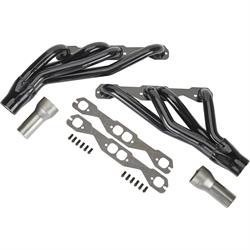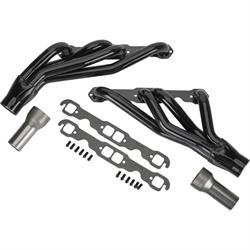Tuning Tips after Header Installation
In 2024 IMCA permitted Hobby Stocks to compete with headers in place of the OEM exhaust manifolds. Hobby Stock drivers competing with a 602 crate engine can use Schoenfeld header 1485-CM2-22 (Speedway part number 917-1485CM222) with a 2-1/4-inch diameter exhaust pipe. Those competing with a claim engine can use a Schoenfeld header part no. 1485-20 (Speedway part number 9171485-20) with a 2-inch diameter exhaust pipe. This is a much cheaper solution than trying to find old LT-1 exhaust manifolds as had been done before.
Making the switch from exhaust manifolds to headers is a well-known upgrade for your exhaust. The performance gains are well documented as we show in our Exhaust Manifolds vs. Headers comparison. In many cases and particularly with the Hobby Stock engines, bolting on new headers has been sufficient but some cases may require a little more consideration. We'll discuss what types of tuning changes to make and troubleshooting tips, however the exact amount of change is dependent on your engine, your track, weather, driving style and other factors.
Monitor Spark Plugs
Reading spark plugs is a crucial diagnostic tool when switching to headers. After installing the headers and making initial adjustments, you need to drive the car and inspect the plugs after. You’re looking for a medium tan or light brown color as an indicator of a proper air-fuel mixture. If they appear too white (lean), you risk detonation; too black (rich), and you could have excessive fuel consumption or fouled plugs. If you see inconsistent readings across the plugs, you might also want to verify whether the headers are seated and sealed correctly, as exhaust leaks can affect performance. This document on plug reading is a helpful overview. If your performance is suffering we have some tips to follow below.
Adjust the Timing
Headers can cause the engine to breathe more efficiently, which may necessitate advancing the timing slightly to optimize performance. Advancing the timing by 2-4 degrees is typically a good starting point, but always test for any signs of engine knock (pinging) under load. If spark knock occurs, it’s essential to dial back the timing to avoid potential damage.
Richen the Air/Fuel Mixture
Switching from the stock exhaust manifolds to headers often improves exhaust flow, reducing back pressure. This can result in a leaner air-fuel mixture because more air enters the cylinders, requiring more fuel to maintain an optimal mixture. Increasing the amount of fuel (richening) is a common recommendation to compensate for this increased airflow. It's essential to perform this adjustment incrementally and monitor the engine’s response to avoid over-richening the mixture.
Exhaust Gasket and Mounting Tips
Make sure to use high-quality gaskets when installing the headers to prevent leaks. It’s common to use copper or multi-layer steel gaskets to ensure a proper seal. When tightening the header bolts, follow the manufacturer’s torque specifications and consider using locking fasteners to prevent the bolts from loosening due to vibration and heat cycling. It’s also a good idea to re-torque the header bolts after the initial heat cycle (first drive) as the expansion and contraction can cause bolts to loosen slightly.
Exhaust Backpressure Considerations
Headers reduce exhaust backpressure, but too little backpressure can also have adverse effects on low-end torque. While headers typically improve top-end horsepower, there can be a trade-off in terms of torque in the lower RPM range.
Drive and Adjust
A thorough test drive is essential after carburetor and timing adjustments. Ideally, you'll want to test the car at various RPMs and loads. If it feels sluggish or exhibits flat spots, further fine-tuning may be needed, especially with the air-fuel mixture or timing.
In addition, listen for exhaust leaks around the header flanges, as improper sealing can reduce the headers' efficiency. Exhaust leaks can often be diagnosed by a ticking noise under acceleration, and in severe cases, they may impact the engine’s ability to breathe properly.

